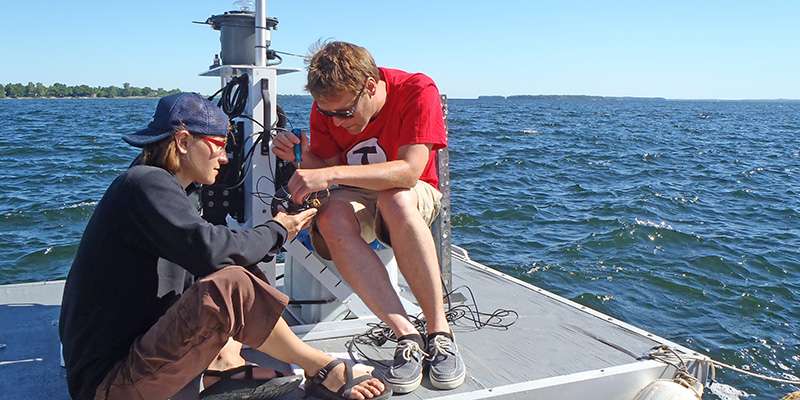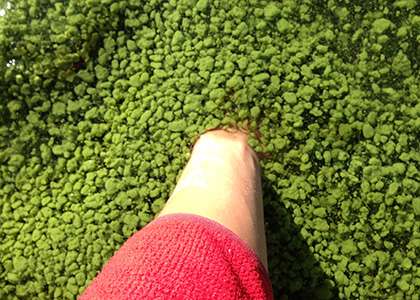Missisquoi Bay's worst algae bloom tied to low spring snowmelt and hot, dry summer conditions

Several factors combined to drive the worst blue-green algae bloom in northeastern Lake Champlain's Missisquoi Bay in recent history. Scientists attribute these unsightly and toxin-producing blue-green algae, or cyanobacteria, blooms to a changing climate and changing nutrient inputs from our intensifying land use practices.
Typically, as recorded for Lake Erie's western basin, heavy spring snowmelt and river discharge, coupled with high phosphorus inputs which upset a lake's ecological balance, contribute to severe summer algae blooms. This was not the case for Missiquoi Bay's 2012 record bloom, recently report researchers at the University of Vermont Rubenstein Ecosystem Science Laboratory.
"Lake Champlain is geographically, geologically, and ecologically similar to western Lake Erie, so we expected to find many of the same factors driving the severity of algae blooms," states Peter Isles, a Rubenstein School doctoral student conducting the research for his dissertation.
Instead, a hot, dry summer in Vermont's Lake Champlain Basin, coupled with a low spring snowmelt discharge and limited nitrogen inputs into the Lake, made for the strongest bloom in Missisquoi Bay in years past or since. Certain cyanobacteria are well-adapted to low nitrogen conditions. Species dominating the 2012 bloom could fix, or use, atmospheric nitrogen to survive.

Bloom-producing cyanobacteria populations can double in a day. Long-term monitoring data from the Vermont and New York Departments of Environmental Conservation, the Lake Champlain Basin Program, and other UVM researchers, although critical to Isles' research, are collected weekly at best, leaving gaps in the data. Isles needed more frequent data for his research and to help the state get a better handle on what drives the severity of blue-green algae blooms in Lake Champlain.
Early in 2012, Isles and his team of scientists at the University of Vermont installed new sensor technology, never before used on the Lake. Mounted on a floating platform about a mile out into Missisquoi Bay, the sensor equipment collects nearly continuous measurements of water temperature, dissolved oxygen, conductivity, and turbidity and retrieves daily water samples for nutrient testing. The sensors also measure concentrations of chlorophyll and phycocyanin, green and blue pigments produced by the cyanobacteria.
In August 2012, using the new sensors, the researchers recorded extremely high concentrations of chlorophyll, indicating a severe algae bloom. Summer water samples also tested high for concentrations of phosphorus, probably released from sediments in the Lake, explains Isles.
"The hot dry year, low spring discharge, limited nitrogen, calm summer weather, stagnant water column, release of high levels of phosphorus, and shallowness of the Bay are all factors that contributed to cause the Bay's most severe blue-green algae bloom on record," reports Isles.

This was the research team's first look at Missisquoi Bay, and their findings form the foundation for Isles' dissertation product – a model to predict future bloom severity based on water and sediment chemistry, global climate models, and watershed hydrology.
"We need to tease out climate impacts on the blooms—is a warming climate going to make them worse? Then we can begin to clarify if phosphorus reductions are working to lessen bloom severity," states Isles.
The research is reported in the Journal of Great Lakes Research.
More information: "Dynamic internal drivers of a historically severe cyanobacteria bloom in Lake Champlain revealed through comprehensive monitoring," Journal of Great Lakes Research, Available online 10 July 2015, ISSN 0380-1330, dx.doi.org/10.1016/j.jglr.2015.06.006
Provided by University of Vermont



















